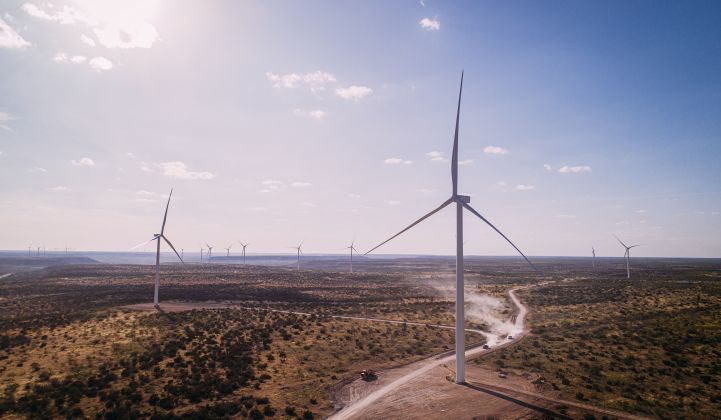The U.S. wind market’s overwhelming focus is on the next few years, when the federal Production Tax Credit remains at or near its full value. Quietly, however, some developers have begun investing beyond the PTC horizon.
“We see a little bit of a countercyclical opportunity because a lot of the large strategic investors — not all of them, but some — are really focused on the phaseout and not investing in greenfield [development],” said Michael Rucker, CEO of Scout Clean Energy, a Colorado-based wind developer.
“We are actively originating greenfield projects with a time horizon of three to five years,” Rucker told Greentech Media. “We’re looking to have a sustainable pipeline of wind projects that goes beyond the PTC phaseout period.”
2020 is the final year to complete wind farms qualified for the full PTC, which phases down to nothing for projects built in 2024.
Scout’s interest in post-PTC projects is noteworthy because the developer was launched just three years ago with the intention of quickly amassing a portfolio of PTC-qualified projects and bringing them online over the course of the phaseout period.
In taking that approach, Scout was anything but unusual. Wood Mackenzie expects more than 30 gigawatts of new U.S. wind capacity to reach completion in the 2019-2021 period, a concentrated burst of wind farm construction never before seen outside China.
However, WoodMac sees the U.S. wind market cooling off considerably after that, dipping into the 4 to 5 gigawatt per year range from 2022 and onward, despite an anticipated lift from the incipient offshore sector.
Scout, for one, is undaunted. There are several reasons to think the onshore wind market will remain healthy into the 2020s without the PTC, Rucker said.
Life beyond the PTC
First and foremost is turbine technology.
Turbine makers are locked in a period of intense global competition, weighing on their profits and spurring industry consolidation. While unpleasant for the manufacturers, such competition has resulted in an unprecedented pace of product evolution and innovation.
GE, Vestas and Siemens Gamesa have all announced new onshore turbines rated above 5 megawatts in the past year, a scale that once would have seemed large even offshore.
“It feels like there’s a new generation of turbines introduced almost every year now,” said Rucker, whose career includes stints at now-defunct turbine maker Clipper Windpower and German developer Juwi.
The PTC’s sunset will put upward pressure on wind offtake prices, but it will also bring lasting efficiencies to a market accustomed to dramatic subsidy cliffs and last-minute extensions, Rucker said.
“I shouldn’t be critical of the PTC because I’ve taken advantage of it in every project I’ve ever been involved with," he said. “But in a way, it’s a very inefficient way to structure a market."
"The stop-start nature of the PTC historically is not efficient for anybody — not for developers, not for manufacturers, and not for the commodity markets where we draw the components we need for turbines.”
The complexities of the PTC and the need for tax equity mean big legal bills for each project. And with a limited number of mostly institutional investors willing to provide tax equity for renewables, “it crowds out a lot of smaller investors that I think would like to participate in projects,” Rucker said.
"Would I turn down an extension of the PTC? Probably not. But I'm not lobbying for one."
Like many renewables developers, Rucker believes additional policy support will eventually materialize in the form of a carbon price, a national clean-energy standard, or some other mechanism.
"But we don't plan on that happening," he noted. "Our forward assumptions are based on what we see now. We're not banking on incentives, but I think there probably will be something in the future."
Competition with solar
Scout’s strategic focus began to shift in 2017 when it was acquired by Quinbrook Infrastructure Partners. Quinbrook’s investment has allowed Scout to become an owner-operator of wind projects rather than simply looking to sell them.
The developer is growing rapidly. Scout has a little more than 200 megawatts of capacity in operation today, and it’s on track to have about 1 gigawatt in the ground by the end of 2020. Last week the developer reached financial close on its 180-megawatt Heart of Texas project.
“The idea is to get to 2 to 3 gigawatts by the time the PTC is fully phased out,” Rucker said.
Quinbrook itself is becoming an increasingly important player in U.S. renewables. In June, the investor secured a power-purchase agreement for a 690-megawatt solar-plus-storage project in Nevada. Energy storage developer GlidePath Power Solutions, another company in Quinbrook's portfolio, last week acquired distributed wind assets in Texas where it intends to deploy batteries.
Like many U.S. wind developers, Scout is looking for ways to expand its presence in solar over time, but it's not planning a dramatic pivot.
There are parts of the U.S. where solar is already more cost-competitive than wind, including much of the Southwest and Southeast. In places like the Northeast and the mid-Atlantic region, solar is simply becoming the "permittable" option, Rucker said.
But across much of the country's interior and northern regions, "wind continues to be — and will be for the foreseeable future — the most competitive renewable resource, particularly at scale," he said.




